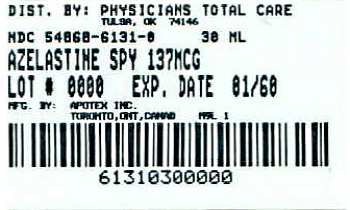Label: AZELASTINE HYDROCHLORIDE spray, metered
-
Contains inactivated NDC Code(s)
NDC Code(s): 54868-6131-0 - Packager: Physicians Total Care, Inc.
- This is a repackaged label.
- Source NDC Code(s): 60505-0833
- Category: HUMAN PRESCRIPTION DRUG LABEL
- DEA Schedule: None
- Marketing Status: Abbreviated New Drug Application
Drug Label Information
Updated February 25, 2010
If you are a consumer or patient please visit this version.
- Download DRUG LABEL INFO: PDF XML
- Official Label (Printer Friendly)
-
DESCRIPTION
Azelastine Hydrochloride Nasal Solution 0.1% (Nasal Spray), 137 micrograms (mcg) per spray, is an antihistamine formulated as a metered-spray solution for intranasal administration. Azelastine hydrochloride occurs as a white, almost odorless, crystalline powder with a bitter taste. It has a molecular weight of 418.37. It is sparingly soluble in water, methanol, and propylene glycol and slightly soluble in ethanol, octanol, and glycerine. It has a melting point of about 225ºC and the pH of a saturated solution is between 5.0 and 5.4. Its chemical name is (±)-1-(2H)-phthalazinone,4-[(4-chlorophenyl) methyl]-2-(hexahydro-1-methyl-1H-azepin-4-yl)-, monohydrochloride. Its molecular formula is C22H24ClN3O•HCl with the following chemical structure:
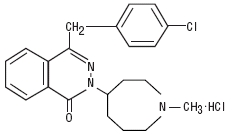
Azelastine hydrochloride nasal solution contains 0.1% azelastine hydrochloride in an aqueous solution at pH 6.8 ± 0.3. It also contains benzalkonium chloride (125 mcg/mL), citric acid, dibasic sodium phosphate, edetate disodium, hypromellose, purified water and sodium chloride.
After priming, each metered spray delivers a 0.137 mL mean volume containing 137 mcg of azelastine hydrochloride (equivalent to 125 mcg of azelastine base). The bottle can deliver 200 metered sprays.
-
CLINICAL PHARMACOLOGY
Azelastine hydrochloride, a phthalazinone derivative, exhibits histamine H1-receptor antagonist activity in isolated tissues, animal models, and humans. Azelastine hydrochloride nasal solution is administered as a racemic mixture with no difference in pharmacologic activity noted between the enantiomers in in vitro studies. The major metabolite, desmethylazelastine, also possesses H1-receptor antagonist activity.
Pharmacokinetics and Metabolism
After intranasal administration, the systemic bioavailability of azelastine hydrochloride is approximately 40%. Maximum plasma concentrations (Cmax) are achieved in 2-3 hours. Based on intravenous and oral administration, the elimination half-life, steady-state volume of distribution, and plasma clearance are 22 hours, 14.5 L/kg, and 0.5 L/h/kg, respectively. Approximately 75% of an oral dose of radiolabeled azelastine hydrochloride was excreted in the feces with less than 10% as unchanged azelastine. Azelastine is oxidatively metabolized to the principal active metabolite, desmethylazelastine, by the cytochrome P450 enzyme system. The specific P450 isoforms responsible for the biotransformation of azelastine have not been identified; however, clinical interaction studies with the known CYP3A4 inhibitor erythromycin failed to demonstrate a pharmacokinetic interaction. In a multiple-dose, steady-state drug interaction study in normal volunteers, cimetidine (400 mg twice daily), a nonspecific P450 inhibitor, raised orally administered mean azelastine (4 mg twice daily) concentrations by approximately 65%.
The major active metabolite, desmethylazelastine, was not measurable (below assay limits) after single-dose intranasal administration of azelastine hydrochloride. After intranasal dosing of azelastine hydrochloride to steady-state, plasma concentrations of desmethylazelastine range from 20-50% of azelastine concentrations. When azelastine hydrochloride is administered orally, desmethylazelastine has an elimination half-life of 54 hours. Limited data indicate that the metabolite profile is similar when azelastine hydrochloride is administered via the intranasal or oral route.
In vitro studies with human plasma indicate that the plasma protein binding of azelastine and desmethylazelastine are approximately 88% and 97%, respectively.
Azelastine hydrochloride administered intranasally at doses above two sprays per nostril twice daily for 29 days resulted in greater than proportional increases in Cmax and area under the curve (AUC) for azelastine.
Studies in healthy subjects administered oral doses of azelastine hydrochloride demonstrated linear responses in Cmax and AUC.
Special Populations
Following oral administration, pharmacokinetic parameters were not influenced by age, gender, or hepatic impairment.
Based on oral, single-dose studies, renal insufficiency (creatinine clearance <50 mL/min) resulted in a 70-75% higher Cmax and AUC compared to normal subjects. Time to maximum concentration was unchanged.
Oral azelastine has been safely administered to over 1400 asthmatic subjects, supporting the safety of administering azelastine hydrochloride nasal solution to allergic rhinitis patients with asthma.
Pharmacodynamics
In a placebo-controlled study (95 subjects with allergic rhinitis), there was no evidence of an effect of azelastine hydrochloride nasal solution (2 sprays per nostril twice daily for 56 days) on cardiac repolarization as represented by the corrected QT interval (QTc) of the electrocardiogram. At higher oral exposures (≥4 mg twice daily), a nonclinically significant mean change on the QTc (3-7 millisecond increase) was observed.
Interaction studies investigating the cardiac repolarization effects of concomitantly administered oral azelastine hydrochloride and erythromycin or ketoconazole were conducted. Oral erythromycin had no effect on azelastine pharmacokinetics or QTc based on analysis of serial electrocardiograms. Ketoconazole interfered with the measurement of azelastine plasma levels; however, no effects on QTc were observed (see PRECAUTIONS, Drug Interactions ).
Clinical Trials
Seasonal Allergic Rhinitis
Trials Supporting Two Sprays Per Nostril Twice Daily
U.S. placebo-controlled clinical trials of azelastine hydrochloride nasal solution included 322 patients with seasonal allergic rhinitis who received two sprays per nostril twice a day for up to 4 weeks. These trials included 55 pediatric patients ages 12 to 16 years. Azelastine hydrochloride nasal solution showed significant improvement compared to placebo in the two primary efficacy variables – the Total Symptom Complex (TSC) and the Major Symptom Complex (MSC). The results for the MSC are shown in Table 1 as the mean change from Baseline in the average of individual symptoms of nose blows, sneezes, runny nose/sniffles, itchy nose and watery eyes as assessed by patients on a 0-5 categorical scale.
Table 1: Summary of Primary Efficacy* Analyses for Pivotal Studies Supporting Two Sprays Per Nostril Twice Daily.
* Average of individual symptoms of nose blows, sneezes, runny nose/sniffles, itchy nose, and watery eyes as assessed by patients on a 0-5 categorical scale. Azelastine HCl
Nasal SolutionPlacebo Outcomes Azelastine HCl
Nasal Solution
vs. PlaceboMean (SD) Difference
between
TreatmentsP value Study 26: 12 Hour AM and PM Reflective MSC Sample Size N=63 N=60 Baseline 11.48 (4.13) 10.84 (4.53) Change from
Baseline-3.05 (3.51) -1.07 (3.52) 1.98 0.0024 Study 31: 12 Hour AM and PM Reflective MSC Sample Size N=63 N=63 Baseline 12.50 (4.5) 12.18 (4.64) Change from
Baseline-4.10 (3.46) -2.07 (4.01) 2.03 0.0023 Study 33: 12 Hour AM and PM Reflective MSC Sample Size N=66 N=66 Baseline 12.04 (4.03) 11.66 (3.96) Change from
Baseline-3.31 (3.74) -1.96 (3.57) 1.35 0.0374 Trials Supporting One Spray Per Nostril Twice Daily
Two hundred seventy five patients with seasonal allergic rhinitis received azelastine hydrochloride nasal solution one spray per nostril twice daily for 2 weeks in two U.S. placebo-controlled trials. The primary efficacy endpoint was the change from Baseline to Day 14 in the Total Nasal Symptom Score [TNSS] (the average of individual scores of runny nose, sneezing, itchy nose, and nasal congestion) as assessed by patients on a 0-3 categorical scale. Compared to placebo, azelastine hydrochloride nasal solution significantly improved the TNSS. The results are shown in Table 2.
* Average of individual symptoms of runny nose, sneezing, itchy nose, and nasal congestion as assessed by patients on a 0-3 categorical scale. Azelastine HCl
Nasal SolutionPlacebo Outcomes Azelastine HCl
Nasal Solution
vs. PlaceboLS Mean (SD) Difference
between
TreatmentsP value Study 419: 12 Hour AM and PM Reflective TNSS Sample Size N=138 N=141 Baseline 16.34 (4.222) 17.21 (4.316) Change from
Baseline-2.69 (4.789) -1.31 (4.285) 1.38 0.0017 Study 420: 12 Hour AM and PM Reflective TNSS Sample Size N=137 N=136 Baseline 16.62 (4.197) 16.84 (4.768) Change from
Baseline-3.68 (4.163) -2.50 (4.011) 1.18 0.0173 Two-week studies comparing the efficacy (and safety) of azelastine hydrochloride nasal solution two sprays per nostril twice daily versus one spray per nostril twice daily were not conducted.
Other Supporting Studies
In dose-ranging trials, administration of azelastine hydrochloride nasal solution, two sprays per nostril twice daily, resulted in a decrease in symptoms, which reached statistical significance from saline placebo within 3 hours after initial dosing and persisted over the 12-hour dosing interval.
There were no findings on nasal examination in an 8-week study that suggested any adverse effect of azelastine on the nasal mucosa.
Vasomotor Rhinitis
Two hundred sixteen patients with vasomotor rhinitis received azelastine hydrochloride nasal solution two sprays per nostril twice a day in two U.S. placebo controlled trials. These patients had vasomotor rhinitis for at least one year, negative skin tests to indoor and outdoor aeroallergens, negative nasal smears for eosinophils, and negative sinus X-rays. Azelastine hydrochloride nasal solution significantly improved a symptom complex comprised of rhinorrhea, post nasal drip, nasal congestion, and sneezing.
-
INDICATIONS AND USAGE
Azelastine hydrochloride nasal solution is indicated for the treatment of the symptoms of seasonal allergic rhinitis such as rhinorrhea, sneezing, and nasal pruritus in adults and children 5 years and older, and for the treatment of the symptoms of vasomotor rhinitis, such as rhinorrhea, nasal congestion and postnasal drip in adults and children 12 years and older.
- CONTRAINDICATIONS
-
PRECAUTIONS
Activities Requiring Mental Alertness
In clinical trials, the occurrence of somnolence has been reported in some patients taking azelastine hydrochloride nasal solution; due caution should therefore be exercised when driving a car or operating potentially dangerous machinery while using azelastine hydrochloride nasal spray. Concurrent use of azelastine hydrochloride nasal solution with alcohol or other CNS depressants should be avoided because additional reductions in alertness and additional impairment of CNS performance may occur.
Information for Patients
Patients should be instructed to use azelastine hydrochloride nasal solution only as prescribed. For the proper use of the nasal spray and to attain maximum improvement, the patient should read and follow carefully the accompanying patient instructions. Patients should be instructed to prime the delivery system before initial use and after storage for 3 or more days (see PATIENT INSTRUCTIONS FOR USE). Patients should also be instructed to store the bottle upright at room temperature with the pump tightly closed and out of the reach of children. In case of accidental ingestion by a young child, seek professional assistance or contact a poison control center immediately.
Patients should be advised against the concurrent use of azelastine hydrochloride nasal solution with other antihistamines without consulting a physician. Patients who are, or may become, pregnant should be told that this product should be used in pregnancy or during lactation only if the potential benefit justifies the potential risks to the fetus or nursing infant. Patients should be advised to assess their individual responses to azelastine hydrochloride nasal solution before engaging in any activity requiring mental alertness, such as driving a car or operating machinery. Patients should be advised that the concurrent use of azelastine hydrochloride nasal solution with alcohol or other CNS depressants may lead to additional reductions in alertness and impairment of CNS performance and should be avoided (see Drug Interactions ).
Drug Interactions
Concurrent use of azelastine hydrochloride nasal solution with alcohol or other CNS depressants should be avoided because additional reductions in alertness and additional impairment of CNS performance may occur.
Cimetidine (400 mg twice daily) increased the mean Cmax and AUC of orally administered azelastine hydrochloride (4 mg twice daily) by approximately 65%. Ranitidine hydrochloride (150 mg twice daily) had no effect on azelastine pharmacokinetics.
Interaction studies investigating the cardiac effects, as measured by the corrected QT interval (QTc), of concomitantly administered oral azelastine hydrochloride and erythromycin or ketoconazole were conducted. Oral erythromycin (500 mg three times daily for seven days) had no effect on azelastine pharmacokinetics or QTc based on analyses of serial electrocardiograms. Ketoconazole (200 mg twice daily for seven days) interfered with the measurement of azelastine plasma concentrations; however, no effects on QTc were observed.
No significant pharmacokinetic interaction was observed with the coadministration of an oral 4 mg dose of azelastine hydrochloride twice daily and theophylline 300 mg or 400 mg twice daily.
Carcinogenesis, Mutagenesis, Impairment of Fertility
In 2 year carcinogenicity studies in rats and mice azelastine hydrochloride did not show evidence of carcinogenicity at oral doses up to 30 mg/kg and 25 mg/kg, respectively (approximately 240 and 100 times the maximum recommended daily intranasal dose in adults and children on a mg/m2 basis).
Azelastine hydrochloride showed no genotoxic effects in the Ames test, DNA repair test, mouse lymphoma forward mutation assay, mouse micronucleus test, or chromosomal aberration test in rat bone marrow.
Reproduction and fertility studies in rats showed no effects on male or female fertility at oral doses up to 30 mg/kg (approximately 240 times the maximum recommended daily intranasal dose in adults on a mg/m2 basis). At 68.6 mg/kg (approximately 560 times the maximum recommended daily intranasal dose in adults on a mg/m2 basis), the duration of estrous cycles was prolonged and copulatory activity and the number of pregnancies were decreased. The numbers of corpora lutea and implantations were decreased; however, pre-implantation loss was not increased.
Pregnancy Category C
Azelastine hydrochloride has been shown to cause developmental toxicity. Treatment of mice with an oral dose of 68.6 mg/kg (approximately 280 times the maximum recommended daily intranasal dose in adults on a mg/m2 basis) caused embryo-fetal death, malformations (cleft palate; short or absent tail; fused, absent or branched ribs), delayed ossification and decreased fetal weight. This dose also caused maternal toxicity as evidenced by decreased body weight. Neither fetal nor maternal effects occurred at a dose of 3 mg/kg (approximately 10 times the maximum recommended daily intranasal dose in adults on a mg/m2 basis).
In rats, an oral dose of 30 mg/kg (approximately 240 times the maximum recommended daily intranasal dose in adults on a mg/m2 basis) caused malformations (oligo-and brachydactylia), delayed ossification and skeletal variations, in the absence of maternal toxicity. At 68.6 mg/kg (approximately 560 times the maximum recommended daily intranasal dose in adults on a mg/m2 basis) azelastine hydrochloride also caused embryo-fetal death and decreased fetal weight; however, the 68.6 mg/kg dose caused severe maternal toxicity. Neither fetal nor maternal effects occurred at a dose of 3 mg/kg (approximately 25 times the maximum recommended daily intranasal dose in adults on a mg/m2 basis).
In rabbits, oral doses of 30 mg/kg and greater (approximately 500 times the maximum recommended daily intranasal dose in adults on a mg/m2 basis) caused abortion, delayed ossification and decreased fetal weight; however, these doses also resulted in severe maternal toxicity. Neither fetal nor maternal effects occurred at a dose of 0.3 mg/kg (approximately 5 times the maximum recommended daily intranasal dose in adults on a mg/m2 basis).
There are no adequate and well-controlled clinical studies in pregnant women. Azelastine hydrochloride nasal solution should be used during pregnancy only if the potential benefit justifies the potential risk to the fetus.
Nursing Mothers
It is not known whether azelastine hydrochloride is excreted in human milk. Because many drugs are excreted in human milk, caution should be exercised when azelastine hydrochloride nasal solution is administered to a nursing woman.
Pediatric Use
The safety and effectiveness of azelastine hydrochloride nasal solution at a dose of 1 spray per nostril twice daily has been established for patients 5 through 11 years of age for the treatment of symptoms of seasonal allergic rhinitis. The safety of this dosage of azelastine hydrochloride nasal solution was established in well-controlled studies of this dose in 176 patients 5 to 12 years of age treated for up to 6 weeks. The efficacy of azelastine hydrochloride nasal solution at this dose is based on an extrapolation of the finding of efficacy in adults, on the likelihood that the disease course, pathophysiology and response to treatment are substantially similar in children compared to adults, and on supportive data from controlled clinical trials in patients 5 to 12 years of age at the dose of 1 spray per nostril twice daily. The safety and effectiveness of azelastine hydrochloride nasal solution in patients below the age of 5 years have not been established.
Geriatric Use
Clinical studies of azelastine hydrochloride nasal solution did not include sufficient numbers of subjects aged 65 and over to determine whether they respond differently from younger subjects. Other reported clinical experience has not identified differences in responses between the elderly and younger patients. In general, dose selection for an elderly patient should be cautious, usually starting at the low end of the dosing range, reflecting the greater frequency of decreased hepatic, renal, or cardiac function, and of concomitant disease or other drug therapy.
-
ADVERSE REACTIONS
Seasonal Allergic Rhinitis
Azelastine Hydrochloride Nasal Solution Two Sprays Per Nostril Twice Daily
Adverse experience information for azelastine hydrochloride nasal solution is derived from six well-controlled, 2-day to 8-week clinical studies which included 391 patients who received azelastine hydrochloride nasal solution at a dose of 2 sprays per nostril twice daily. In placebo-controlled efficacy trials, the incidence of discontinuation due to adverse reactions in patients receiving azelastine hydrochloride nasal solution was not different from vehicle placebo (2.2% vs 2.8%, respectively). In these clinical studies, adverse events that occurred more often in patients treated with azelastine hydrochloride nasal solution versus vehicle placebo included bitter taste (19.7% vs 0.6%), somnolence (11.5% vs 5.4%), weight increase (2.0% vs 0%), and myalgia (1.5% vs 0%).
The following table contains adverse events that were reported with frequencies ≥2% in the azelastine hydrochloride nasal solution 2 sprays per nostril twice daily treatment group and more frequently than placebo in short-term (≤2 days) and long-term (2-8 weeks) clinical trials.
ADVERSE EVENT Azelastine HCl
Nasal Spray
n = 391Vehicle
Placebo
n = 353Bitter Taste 19.7 0.6 Headache 14.8 12.7 Somnolence 11.5 5.4 Nasal Burning 4.1 1.7 Pharyngitis 3.8 2.8 Dry Mouth 2.8 1.7 Paroxysmal Sneezing 3.1 1.1 Nausea 2.8 1.1 Rhinitis 2.3 1.4 Fatigue 2.3 1.4 Dizziness 2.0 1.4 Epistaxis 2.0 1.4 Weight Increase 2.0 0.0 Azelastine Hydrochloride Nasal Solution One Spray Per Nostril Twice Daily
Adverse experience information for azelastine hydrochloride nasal solution at a dose of one spray per nostril twice daily is derived from two placebo-controlled 2-week clinical studies which included 276 patients. None of the patients receiving azelastine hydrochloride nasal solution were discontinued from these studies due to adverse reactions. Three patients receiving vehicle placebo were discontinued due to adverse reactions. Bitter taste was reported in 8.3% of patients compared to none in the placebo group. Somnolence was reported in 0.4% of patients compared to none in the placebo group.
A total of 176 patients 5 to 12 years of age were exposed to azelastine hydrochloride nasal solution at a dose of 1 spray each nostril twice daily in 3 placebo-controlled studies. In these studies, adverse events that occurred more frequently in patients treated with azelastine hydrochloride nasal solution than with placebo, and that were not represented in the adult adverse event table above include rhinitis/cold symptoms (17.0% vs 9.5%), cough (11.4% vs 8.3%), conjunctivitis (5.1% vs 1.8%), and asthma (4.5% vs 4.1%).
The following events were observed infrequently (<2% and exceeding placebo incidence) in patients who received azelastine hydrochloride nasal solution dosed at 1 or 2 sprays per nostril twice daily in U.S. clinical trials.
Cardiovascular: flushing, hypertension, tachycardia.
Dermatological: contact dermatitis, eczema, hair and follicle infection, furunculosis, skin laceration.
Digestive: constipation, gastroenteritis, glossitis, ulcerative stomatitis, vomiting, increased SGPT, aphthous stomatitis, diarrhea, toothache.
Metabolic and Nutritional: increased appetite.
Musculoskeletal: myalgia, temporomandibular dislocation, rheumatoid arthritis.
Neurological: hyperkinesia, hypoesthesia, vertigo.
Psychological: anxiety, depersonalization, depression, nervousness, sleep disorder, thinking abnormal.
Respiratory: bronchospasm, coughing, throat burning, laryngitis, bronchitis, dry throat, nocturnal dyspnea, nasopharyngitis, nasal congestion, pharyngolaryngeal pain, sinusitis, nasal dryness, paranasal sinus hypersecretion, post nasal drip.
Special Senses: conjunctivitis, eye abnormality, eye pain, watery eyes, taste loss.
Urogenital: albuminuria, amenorrhea, breast pain, hematuria, increased urinary frequency.
Whole Body: allergic reaction, back pain, herpes simplex, viral infection, malaise, pain in extremities, abdominal pain, pyrexia.
-
ADVERSE REACTIONS
Vasomotor Rhinitis
Adverse experience information for azelastine hydrochloride nasal solution is derived from two placebo-controlled clinical studies which included 216 patients who received azelastine hydrochloride nasal solution at a dose of 2 sprays per nostril twice daily for up to 28 days. The incidence of discontinuation due to adverse reactions in patients receiving azelastine hydrochloride nasal solution was not different from vehicle placebo (2.8% vs 2.9%, respectively).
The following adverse events were reported with frequencies ≥2% in the azelastine hydrochloride nasal solution treatment group and more frequently than placebo.
ADVERSE EVENT Azelastine HCl
Nasal Spray
n = 216Vehicle
Placebo
n = 210Bitter Taste 19.4 2.4 Headache 7.9 7.6 Dysesthesia 7.9 3.3 Rhinitis 5.6 2.4 Epistaxis 3.2 2.4 Sinusitis 3.2 1.9 Somnolence 3.2 1.0 Events observed infrequently (<2% and exceeding placebo incidence) in patients who received azelastine hydrochloride nasal solution (2 sprays/nostril twice daily) in U.S. clinical trials in vasomotor rhinitis were similar to those observed in U.S. clinical trials in seasonal allergic rhinitis.
In controlled trials involving nasal and oral azelastine hydrochloride formulations, there were infrequent occurrences of hepatic transaminase elevations. The clinical relevance of these reports has not been established.
In addition, the following spontaneous adverse events have been reported during the marketing of azelastine hydrochloride nasal solution and causal relationship with the drug is unknown: anaphylactoid reaction, application site irritation, atrial fibrillation, chest pain, confusion, dyspnea, facial edema, involuntary muscle contractions, palpitations, paresthesia, parosmia, pruritus, rash, disturbance or loss of sense of smell and/or taste, tolerance, urinary retention, vision abnormal, and xerophthalmia.
-
OVERDOSAGE
There have been no reported overdosages with azelastine hydrochloride nasal solution. Acute overdosage by adults with this dosage form is unlikely to result in clinically significant adverse events, other than increased somnolence, since one bottle of azelastine hydrochloride nasal solution contains 30 mg of azelastine hydrochloride. Clinical studies in adults with single doses of the oral formulation of azelastine hydrochloride (up to 16 mg) have not resulted in increased incidence of serious adverse events. General supportive measures should be employed if overdosage occurs. There is no known antidote to azelastine hydrochloride nasal solution. Oral ingestion of antihistamines has the potential to cause serious adverse effects in young children. Accordingly, azelastine hydrochloride nasal solution should be kept out of the reach of children. Oral doses of 120 mg/kg and greater (approximately 460 times the maximum recommended daily intranasal dose in adults and children on a mg/m2 basis) were lethal in mice. Responses seen prior to death were tremor, convulsions, decreased muscle tone, and salivation. In dogs, single oral doses as high as 10 mg/kg (approximately 260 times the maximum recommended daily intranasal dose in adults and children on a mg/m2 basis) were well tolerated, but single oral doses of 20 mg/kg were lethal.
-
DOSAGE AND ADMINISTRATION
Seasonal Allergic Rhinitis
The recommended dose of azelastine hydrochloride nasal solution in adults and children 12 years and older with seasonal allergic rhinitis is one or two sprays per nostril twice daily. The recommended dose of azelastine hydrochloride nasal solution in children 5 years to 11 years of age is one spray per nostril twice daily.
Vasomotor Rhinitis
The recommended dose of azelastine hydrochloride nasal solution in adults and children 12 years and older with vasomotor rhinitis is two sprays per nostril twice daily. Before initial use, the delivery system should be primed with 4 sprays or until a fine mist appears. When 3 or more days have elapsed since the last use, the pump should be reprimed with 2 sprays or until a fine mist appears.
CAUTION: Avoid spraying in the eyes.
Directions for Use: Illustrated patient instructions for proper use accompany each package of azelastine hydrochloride nasal solution.
-
HOW SUPPLIED
Azelastine Hydrochloride Nasal Solution 0.1% (Nasal Spray), 137 mcg/spray, (NDC 54868-6131-0) is supplied as a package containing 200 metered sprays in a high-density polyethylene (HDPE) bottle fitted with a metered-dose spray pump unit. A leaflet of patient instructions is also provided. The spray pump unit consists of a nasal spray pump fitted with a white safety clip and a white plastic dust cover.
The Azelastine Hydrochloride Nasal Solution 0.1% (Nasal Spray), 137 mcg/spray, bottle contains 30 mg (1 mg/mL) of azelastine hydrochloride. The bottle can deliver 200 metered sprays. Each spray delivers a mean of 0.137 mL solution containing 137 mcg of azelastine hydrochloride.
Storage
Store upright at 20º-25ºC (68º-77ºF) [See USP Controlled Room Temperature]. Protect from freezing.
Keep bottle tightly closed and away from children.
Manufactured by: Manufactured for:
Apotex Inc. Apotex Corp.
Toronto, Ontario Weston, FL
Canada M9L 1T9
33326
241533
January 2009
Relabeling and Repackaging by:
Physicians Total Care, Inc.
Tulsa, OK 74146
-
PATIENT: How to Use Instructions
FOR INTRANASAL USE ONLY
IMPORTANT: FOLLOW INSTRUCTIONS CAREFULLY TO ENSURE PROPER DOSING.
DOSING: The dosage of azelastine hydrochloride nasal solution is 1 spray per nostril twice daily for pediatric patients (ages 5-11 years) with seasonal allergic rhinitis. For patients age 12 and older with seasonal allergic rhinitis the dosage is one or two sprays per nostril twice daily. For patients age 12 and older with nonallergic vasomotor rhinitis the dosage is two sprays per nostril twice daily. Keep your head tilted downward when spraying. Alternate sprays between nostrils. Breathe gently to avoid drawing any medication into the throat. Follow the instructions below to use your Azelastine Hydrochloride Nasal Solution 0.1% (Nasal Spray) pump.

TO PRIME:
1. Remove and retain the white spray tip dust cover and white spray clip.
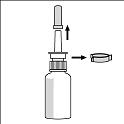
2. Prime for initial use by putting two fingers on the shoulders of the spray pump unit and place your thumb on the bottom of the bottle. Press upward with thumb, release, and repeat until a fine mist appears (4 sprays or less). Now your pump is primed and ready to use.
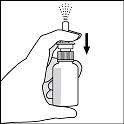
3. If the solution is delivered in a stream of liquid, it may fail to provide maximum benefit and cause some discomfort. A fine mist can be produced only by a rapid and firm pumping action.
4. When 3 or more days have elapsed since the last use, the pump should be reprimed with 2 sprays or until a fine mist appears.
TO USE:
1. Gently blow nose to clear nostrils.
2. Keep your head tilted downward toward your toes.
3. Place the spray tip ¼ to ½ inch into one nostril. Hold bottle vertically upright (as shown), allowing spray tip to aim toward the back of the nose. Close other nostril with finger, rapidly press once with thumb and sniff gently at the same time. You may feel a brief burning or stinging sensation after using the unit.

4. Repeat in other nostril.
5. For patients aged 12 and over who were instructed by their doctor to administer 2 sprays in each nostril, repeat Steps 2 and 3 for second spray, again alternating sprays between nostrils.
6. Breathe in gently, and do not tilt head back after dosing to avoid drawing medication into the throat (where it will be tasted).
CAUTION: Keep bottle tightly closed and away from children. In case of accidental ingestion by a young child, seek professional assistance or contact a poison control center immediately. Do not spray in eyes.
NOTE: Keep the dust cover and safety clip on the spray pump unit when not in use. After each use and before replacing the dust cover, wipe the spray tip with a clean tissue or cloth.
TO CLEAN:
1. If spray nozzle becomes clogged, DO NOT ATTEMPT TO CLEAR IT USING A POINTED OBJECT.Remove the spray pump unit from the bottle.
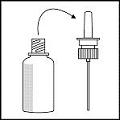
2. Soak only the spray pump unit in warm water.Squirt several times while holding under water.
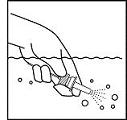
3. Make sure the spray pump unit is dry.
4. Reinsert the pump into the open bottle and tighten by turning clockwise.
5. To avoid leakage, firm pressure is required to ensure that the pump is fully threaded onto the bottle.
6. Follow instructions for priming.
Store upright at 20º-25ºC (68º-77ºF) [See USP Controlled Room Temperature]. Protect from freezing. Keep bottle tightly closed and away from children.
Manufactured by: Manufactured for: Apotex Inc. Apotex Corp. Toronto, Ontario Weston, FL Canada M9L 1T9 33326 241533
January 2009
- PRINCIPAL DISPLAY PANEL
-
INGREDIENTS AND APPEARANCE
AZELASTINE HYDROCHLORIDE
azelastine hydrochloride spray, meteredProduct Information Product Type HUMAN PRESCRIPTION DRUG Item Code (Source) NDC:54868-6131(NDC:60505-0833) Route of Administration NASAL Active Ingredient/Active Moiety Ingredient Name Basis of Strength Strength azelastine hydrochloride (UNII: 0L591QR10I) (azelastine - UNII:ZQI909440X) azelastine hydrochloride 137 ug Inactive Ingredients Ingredient Name Strength BENZALKONIUM CHLORIDE (UNII: F5UM2KM3W7) EDETATE DISODIUM (UNII: 7FLD91C86K) HYPROMELLOSES (UNII: 3NXW29V3WO) CITRIC ACID MONOHYDRATE (UNII: 2968PHW8QP) SODIUM PHOSPHATE, DIBASIC (UNII: GR686LBA74) SODIUM CHLORIDE (UNII: 451W47IQ8X) WATER (UNII: 059QF0KO0R) Packaging # Item Code Package Description Marketing Start Date Marketing End Date 1 NDC:54868-6131-0 1 in 1 CARTON 1 200 in 1 BOTTLE, SPRAY Marketing Information Marketing Category Application Number or Monograph Citation Marketing Start Date Marketing End Date ANDA ANDA077954 06/28/2011 Labeler - Physicians Total Care, Inc. (194123980) Establishment Name Address ID/FEI Business Operations Physicians Total Care, Inc. 194123980 relabel, repack


